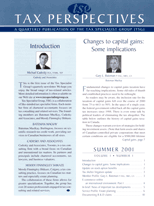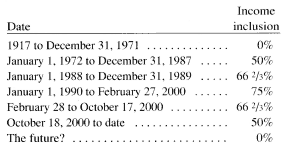
PDF Format
 Issue Contents Issue Contents
 All Issues All Issues
Summer 2001
Volume 1, Number 1
The information in Tax Perspectives is prepared for general interest only. Every effort has been made to ensure that the contents are accurate. However, professional advice should always be obtained before acting and TSG member firms cannot assume any liability for persons who act on the basis of information contained herein without professional advice.
Changes to Capital Gains: Some Implications
Fundamental changes to capital gains taxation have far-reaching implications. Some old rules of thumb and established practices need to be rethought.
As readers may be aware, the inclusion rate for the taxation of capital gains fell over the course of 2000 from 75 to 662/3 to 50%. In the space of a single year, the federal government rolled back all the capital gains tax increases since 1988. There is even some talk by political leaders of eliminating the tax altogether. The table below outlines the history of capital gains taxation in Canada.
 These changes warrant a review of strategies for holding investment assets. (Note that farm assets and shares of Canadian-controlled private corporations that meet certain conditions are eligible for a $500,000 lifetime capital gains exemption and are not discussed here.) In this article we consider two of the most common strategies: investing through RRSPs and estate freezes. These changes warrant a review of strategies for holding investment assets. (Note that farm assets and shares of Canadian-controlled private corporations that meet certain conditions are eligible for a $500,000 lifetime capital gains exemption and are not discussed here.) In this article we consider two of the most common strategies: investing through RRSPs and estate freezes.
The table below provides the context for this review. It shows the tax rates for different types of income, across all provinces at the top marginal rate, which for 2001 is over $100,000. Capital gains in 2001 are taxed at half the rate at which interest income is taxed for all tax brackets and in all provinces.

RRSPs
RRSP investment strategies need to be rethought. Many Canadians have the majority of their investment capital in RRSPs, and use these vehicles for interest-bearing, dividend-paying, and appreciating investments. The effect of a capital gains inclusion rate reduction is important to consider.
RRSPs are valuable for their tax-free compounding of investment income. But if the rate of return on an asset is predominantly capital appreciation, tax will arise only when the asset is sold. Using RRSPs to defer the tax on capital gains investments is a strategy that should be approached now with caution. Capital gains on the sale of RRSP assets may be taxed at the top rate when the funds are ultimately withdrawn.
For example, a bank stock, based on average performance over the last 40 years, doubles every 7 years and pays a dividend of about 3%. If an initial investment of $10,000 were held 21 years within an RRSP, it would grow to $80,000. On withdrawal, the entire $80,000 would be taxable, at a rate of about 46% (in Ontario).
Tax of $36,800 would be due, leaving net proceeds of $43,200. However, if the same investment were held outside an RRSP, the tax due on sale in 21 years would be $16,100, leaving $63,900 after tax. In order for the tax-free compounding of the dividend income to compensate for the doubling of the tax on the capital appreciation, the hold period of an investment has to be 50 years! Of course, this assumes that the share investment will be retained for 21 years. Otherwise, the tax deferral on reinvestment of the capital gain would have to be considered.
This strategy change goes right to the heart of the value of the RRSP. We advise that the use of RRSPs for capital gains investments should be reserved for trading accounts (which would otherwise be on income account) and the fixed-income portion of an investment strategy. Long-term stock holders should resist the quick fix of the RRSP deduction and hold these assets outside an RRSP for substantial advantage.
ESTATE FREEZES
Taxpayers often want to freeze future growth in their estate, to ensure that the growth is earned by the next generation. This is commonly done by converting the current value of the estate into fixed value preferred shares of a holding company and then redeeming those shares over time. This converts the capital gains tax, currently calculated but not due, into a future stream of dividends with immediate taxability on each redemption.
Although this strategy used to save tax, as the figures in the table show, it will now increase the tax on assets by a substantial margin and move the taxation up from "later" to annual hits.
Consider that the tax rate on dividends is around 31% (in Ontario). Last year, capital gains were taxed at about 36%. Now they are taxed at 23%. This is a dramatic change.
Readers who wish to review their financial strategies in light of the changes in the taxation of capital gains should contact one of our member firms for expert assistance and advice.
| 




 These changes warrant a review of strategies for holding investment assets. (Note that farm assets and shares of Canadian-controlled private corporations that meet certain conditions are eligible for a $500,000 lifetime capital gains exemption and are not discussed here.) In this article we consider two of the most common strategies: investing through RRSPs and estate freezes.
These changes warrant a review of strategies for holding investment assets. (Note that farm assets and shares of Canadian-controlled private corporations that meet certain conditions are eligible for a $500,000 lifetime capital gains exemption and are not discussed here.) In this article we consider two of the most common strategies: investing through RRSPs and estate freezes.
